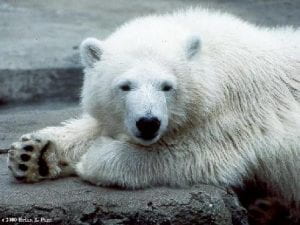The large and furry creature has yellow-ish white fur so it can camouflage from it’s prey. The polar bear is a large white bear from the north. The interesting creature has short round ears to conserve heat. A polar bear eats seals (especially the type called ringed seals). The polar bear can swim several hours with ease.
Description of environment
Polar bears only live in the arctic, where there is floating ice that they can drift on when tiered of swimming. It is cold and windy where they have to find shelter for their cubs so that they are safe and warm.
Behavioural adaptations
The polar bear is frequently touching and grooming their cubs so they can protect them and don’t get hurt by other polar bears. The male polar bears have the aggression to steal food caught by other polar bears during breeding season so that the baby polar bear can have food to eat and will not starve. All polar bears have thick paws to help them run on ice when it’s prey are moving this also helps them to walk around without slipping and falling over.
Physical appearance
The polar bear has a long neck to help the polar bears head stay up in the water. The polar bear has a short tail, this helps them to survive in the cold weather. This large bear can swim several hours without stopping for a break and without eating any food.
Diet
The polar normally eats seals (especially the type called ringed seals). A polar bear can live up to five days without eating, this allows them to have more time to catch their prey. If the polar bear can’t find any seals they tend to eat walruses or whales. Seals take up most of their diet.
Other facts
The polar bear lives up to 33 years old. The polar bear has a good sense of smell this means it can smell it’s prey from up to 16km away. The thick white skin on the outside is covering the black skin so it can camouflage into the snow and ice blocks in the water. There are still 22.000-31.000 polar bears left in the world.
What is your favourite animal?
Do you know any adaptations for your favourite animal?
Leila